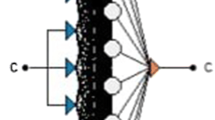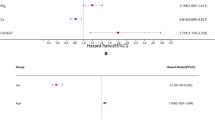Abstract
The pathophysiology of idiopathic calcium oxalate nephrolithiasis involves metabolic abnormalities. Previous studies gave conflicting results about the metabolic factors in stone formers. Artificial neural networks (ANN) are new methods based on computer programming that have outperformed conventional methods in prediction of outcomes in different medical applications. The aim of our study was to compare with ANN the clinical and biochemical parameters implicated in urinary calcium stone between stone formers (SF) and controls (C). We compared 11 clinical and biochemical variables among 119 male idiopathic calcium oxalate SF and 96 C by univariate and multivariate statistical analyses. Univariate analyses included discriminant analysis, logistic regression analysis, and ANN. For multivariate analyses, stepwise discriminant analysis and ANN were performed. Variables included age, body mass index (BMI), family history of nephrolithiasis, supersaturation with respect to calcium oxalate, calcemia, and 24-h urinary calcium, oxalate, uric acid, urea, sodium, and citrate. With univariate and multivariate analyses, ANN were as efficient as classical statistical analyses in discriminating the different parameters. The sensitivity, the specificity, and the percentage of correctly classified patients were similar in all analyses. With ANN, supersaturation (receiver operating characteristic, ROC curves index 0.73) and urea (ROC 0.72) were the most discriminant followed by family history and urinary calcium (ROC 0.67). ROC index was 0.63 for citrate, 0.61 for oxalate and urate, 0.60 for sodium and calcemia, 0.58 for age, and 0.56 for BMI, but these parameters were not statistically different between SF and C. ANN gave additional information since they made it possible to determine the cut-off values of the parameters and their predictive power. Cut-off values for being a stone former were 8.9 for supersaturation and 363 mmol/day for urinary urea with a predictive power of 0.69 and 0.70, respectively. Univariate and multivariate analysis evidenced supersaturation and 24-h urinary urea excretion as the most discriminant parameters between the two populations. In addition to high supersaturation, the negative impact of protein intake was confirmed.



Similar content being viewed by others
References
Johnson CM, Wilson DM, O’Fallon WM et al (1979) Renal stone epidemiology: a 25-year study in Rochester, Minnesota. Kidney Int 16:624–631
Norlin A, Lindell B, Granberg PO, Lindvall N (1976) Urolithiasis: a study of its frequency. Scand J Urol Nephrol 10:150–153
Ljunghall S, Danielson BG (1984) A prospective study of renal stones recurrences. Br J Urol 56:122–124
Goodman HO, Holmes RP, Assimos DG (1995) Genetic factors in calcium oxalate disease. J Urol 153:301–307
Ginalski JM, Portmann L, Jaeger Ph (1990) Does medullary sponge kidney cause nephrolithiasis? Am J Roentgenol 155:299–302
Coe FL, Parks J, Asplin J (1992) The pathogenesis and treatment of kidney stones. N Engl J Med 327:1141–1152
Curhan G, Willett WC, Speizer FE, Stampfer MJ (2001) Twenty-four-hour urine chemistries and the risk of kidney stones among women and men. Kidney Int 59:2290–2298
Bishop CM (1995) Neural networks for pattern recognition. Oxford University Press, Oxford
Masters T (1993) Practical neural networks recipes in C++. Academic, New York
Forsstrom JJ, Dalton KJ (1995) Artificial neural networks for decision support in clinical medicine. Ann Med 27:509–517
Bagli DJ, Agarwal SK, Venkasteswara S et al (1998) Artificial neural networks in pediatric urology: prediction of sonographic outcome following pyeloplasty. J Urol 160:980–983
Baxt WG (1995) Application of neural networks to clinical medicine. Lancet 346:1135–1138
Nafe R, Choritz H (1992) Introduction of a neuronal network as a tool for diagnostic analysis and classification based on experimental pathologic data. Exp Toxicol Pathol 44:17–24
Bottaci L, Drew PJ, Hartley JE et al (1997) Artificial neural networks applied to outcome prediction for colorectal cancer patients in separate institutions. Lancet 350:469–472
Ebell MH (1993) Artificial neural networks for predicting failure to survive following in-hospital cardiopulmonary resuscitation. J Fam Pract 36:297–303
Pofahl WE, Walczak SM, Rhone E, Izenberg SD (1998) Use of an artificial neural network to predict length of stay in acute pancreatitis. Am Surg 64:868–872
Le Goff JM, Lavayssiere L, Rouëssé J, Spyrato F (2000) Nonlinear discriminant analysis and prognostic factor classification in node-negative primary breast cancer using probabilistic neural networks. Anticancer Res 20:2213–2218
Brown CM, Ackerman DK, Purich DL (1994) EQUIL93: a tool for experimental and clinical urolithiasis. Urol Res 22:119–126
Specht D (1990) Probabilistic neural networks. Neural Networks 3:109–118
Goldfarb S (1988) Dietary factors in the pathogenesis and prophylaxis of calcium nephrolithiasis. Kidney Int 34:544–555
Lemann J, Pleuss JA, Worcester EM et al (1996) Urinary oxalate excretion increases with body size and decreases with increasing dietary calcium intake among healthy adults. Kidney Int 49:200–208
Parks JH, Coe FL (1986) A urinary calcium-citrate index for the evaluation of nephrolithiasis. Kidney Int 30:85–90
Hodgkinson A, Pyrah LN (1958) The urinary excretion of calcium and inorganic phosphate in 344 patients with calcium stone of renal origin. Br J Surg 46:10–18
Pak CY, Britton F, Peterson R et al (1980) Ambulatory evaluation of nephrolithiasis: classification, clinical presentation and diagnostic criteria. Am J Med 69:19–30
Larsson L, Tiselius HG (1987) Hyperoxaluria. Miner Electrolyte Metab 13:242–250
Parks JH, Coward M, Coe FL (1997) Correspondence between stone composition and urine supersaturation in nephrolithiasis. Kidney Int 51:894–900
Leonetti F, Dussol B, Berthezene P et al (1998) Dietary and urinary risk factors for stones in idiopathic calcium stone formers compared with healthy subjects. Nephrol Dial Transplant 13:617–622
Rotily M, Leonetti F, Iovanna C et al (2000) Effects of low animal protein or high-fiber diets on urine composition in calcium nephrolithiasis. Kidney Int 57:115–1123
Curhan GC, Willett WC, Rimm EB, Stampfer MJ (1993) Twenty-four-hour urine chemistries and the risk of kidney stones among women and men. N Engl J Med 328:833–838
Nguyen QV, Kälin A, Drouve U et al (2001) Sensitivity to meat protein intake and hyperoxaluria in idiopathic calcium stone formers. Kidney Int 59:2273–2281
Giannini S, Nobile M, Sartori L et al (1999) Acute effects of moderate dietary protein restriction in patients with idiopathic hypercalciuria and calcium nephrolithiasis. Am J Clin Nutr 69:267–271
Borghi L, Schianchi T, Meschi T et al (2002) Comparison of two diets for the prevention of recurrent stones in idiopathic hypercalciuria. N Engl J Med 346:77–84
Osther PJ (1999) Hyperoxaluria in idiopathic calcium nephrolithiasis. What are the limits? Scand J Urol Nephrol 33:368–371
Strauss AL, Coe FL, Parks JH (1982) Formation of a single calcium stone of renal origin. Clinical and laboratory characteristics of patients. Arch Intern Med 142:504–507
Erickson SB, Cooper K, Broadus AE et al (1984) Oxalate absorption and postprandial urine supersaturation in an experimental human model of absorptive hypercalciuria. Clin Sci 67:131–138
Grover PK, Ryall RL (1994) Urate and calcium oxalate stones: from repute to rhetoric to reality. Miner Electrolyte Metab 20:361–370
Sarmina I, Spirnak JP, Resnick MI (1987) Urinary lithiasis in the black population: an epidemiological study and review of the literature. J Urol 138:14–17
Carson CC (1990) Renal calculus disease. Clin Ger Med 6:115–129
Acknowledgements
This work was supported by research grants (Programme Hospitalier de Recherche Clinique N° 99/0050) from the Ministère de la Santé. We thank F. Leonetti, MD, S. Morange, MD, J. Casanova, C. Portelli, O. Pola, and G. Burkhart for their contributions to the study.
Author information
Authors and Affiliations
Corresponding author
Rights and permissions
About this article
Cite this article
Dussol, B., Verdier, JM., Le Goff, JM. et al. Artificial neural networks for assessing the risk of urinary calcium stone among men. Urol Res 34, 17–25 (2006). https://doi.org/10.1007/s00240-005-0006-4
Received:
Accepted:
Published:
Issue Date:
DOI: https://doi.org/10.1007/s00240-005-0006-4




